- Joined
- 4 July 2010
- Messages
- 2,514
- Reaction score
- 3,091
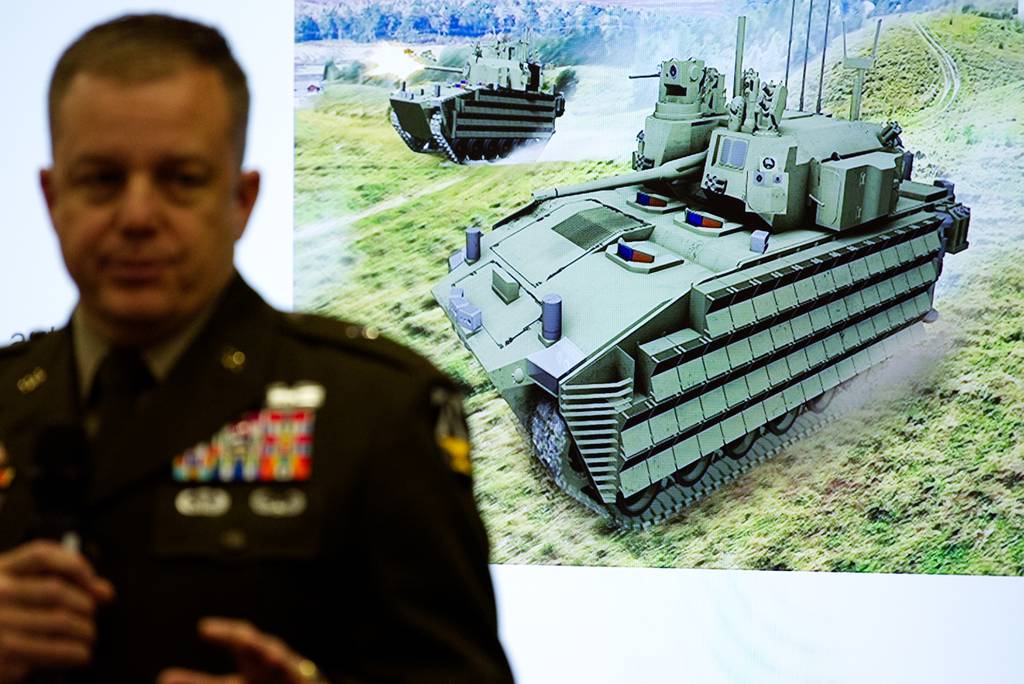
My 2 cents.This has probably been answered elsewhere on this forum but why has the US (or others that I can think of) never adopted a hyper velocity missile on a ground vehicle?
Versions like LOSAT were longer ranged and harder hitting than 120mm cannons IIRC.
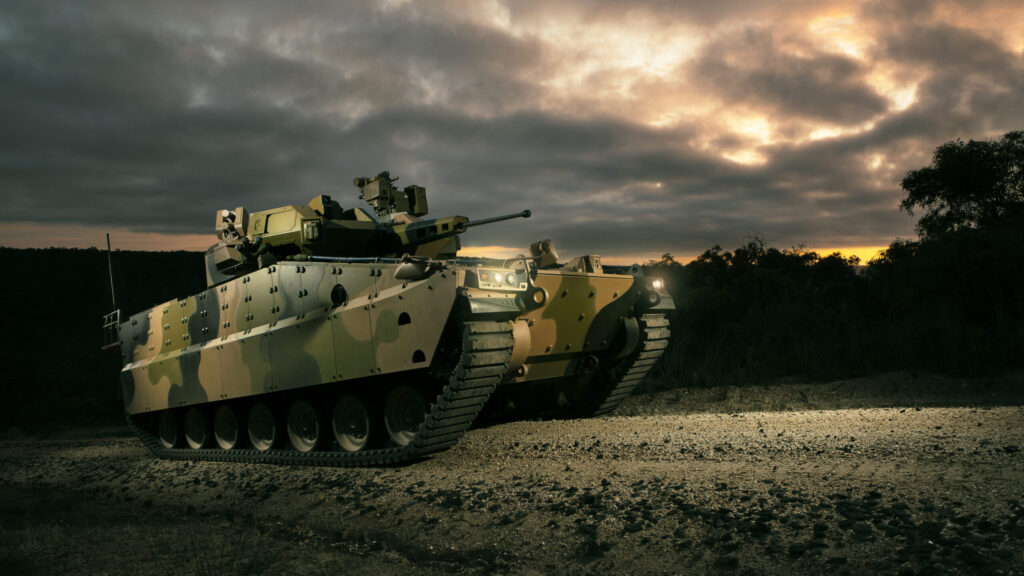
Five teams — led respectively by American Rheinmetall, BAE Systems, General Dynamics, Oshkosh and upstart Point Blank Enterprises — received contracts last year to develop initial digital designs for OMFV. Some have decades of experience making US Army vehicles, others are throwing their hats in the ring for the first time, but all have already gone through three rounds of intense feedback from the Army and revisions to their designs, increasingly converging on similar physical designs:
That’s up from the four or five fully equipped foot troops that can ride in Bradley, but down from the full squad of nine the Army hoped for with the earlier attempted programs. While painful, this reduction in crew size and passenger capacity is critical to keeping down the overall weight and volume of the vehicle, making it easier to fuel, maintain, and transport.
- a tracked vehicle (rather than wheeled) with hybrid-electric drive, which both reduces demand on fuel supplies and allows stealthier “silent watch” and “silent maneuver” modes;
- an unmanned turret boasting a 50 mm autocannon (or a 30 mm with option to upgrade), keeping the entire crew in the less exposed and heavily armored hull;
- a two-person crew — down from the Bradley’s three — assisted by extensive automation, plus passenger space for six infantry soldiers.
Because of the iterative process, the official expected that “these designs are going to be very similar on things the layman would consider, [such as] size, weight, crew, weapons. [Instead,] the differential will be along the lines of artificial intelligence, predictive maintenance.”
Versions like LOSAT were longer ranged and harder hitting than 120mm cannons IIRC.

Returning to the FCS-style distributed propulsion/power system is big time news.
Do you think the BAE choice of the Quinetic In's Modular E-X-Drive Hybrid Electric transmission as NIH will be counter productive as the Army funded the 32 speed Active Combat Transmission, ACT, (part of the Advanced Powertrain Demonstrator) to the tune of several hundred $millions and looking to justify its spend with a variant suitable for the the OMFV, or will the pressure from the Pentagon to electrify Army vehicle fleet act in BAEs favor, they did win a contract for two hybrid electric Bradley's for testing.
A real-life Lego tank: BAE touts modular design for Army OMFV - Breaking Defense
A redesign already trimmed the troop compartment from nine passengers to six, BAE says. Want to upgrade the engine? Load new software? Add a drone-killing laser? Unlike on the old Bradley, there’s plenty of room.breakingdefense.com
I don't know any more about the specifics of this BAE proposal than you, so I couldn't make a serious attempt to confirm or refute that. However, if there is significant weight inefficiency and BAE still feels the packaging and energy efficiency are worth it I'd be willing to see if they can prove it.Returning to the FCS-style distributed propulsion/power system is big time news.
So, let me see if I understand this right. In that FCS slide, it looks like the batteries and electric drive motors are distributed but there is still a single diesel engine up front as the primary power generator.
From the article about OMFV, it sounds like they are proposing a series of smaller generator modules spread around the vehicle? Multiple single-cylinder (opposed piston?) engines driving generators? This sounds really weight-inefficient.
Possible thinking if using a series smaller DG's would allow the DG's to operate them at their most efficient rpm range, it would be possible with DC bus to bring the additional DGs online and offline immediately, no synchronization needed, and as the power load required, saving on fuel usage so overall result in less total weight than using one big DG especially when its operating outside optimum rpm range eg at low rpm in standby mode or requiring installation of a separate small DG or additional batteries, heavy.Returning to the FCS-style distributed propulsion/power system is big time news.
So, let me see if I understand this right. In that FCS slide, it looks like the batteries and electric drive motors are distributed but there is still a single diesel engine up front as the primary power generator.
From the article about OMFV, it sounds like they are proposing a series of smaller generator modules spread around the vehicle? Multiple single-cylinder (opposed piston?) engines driving generators? This sounds really weight-inefficient.
Returning to the FCS-style distributed propulsion/power system is big time news.
So, let me see if I understand this right. In that FCS slide, it looks like the batteries and electric drive motors are distributed but there is still a single diesel engine up front as the primary power generator.
From the article about OMFV, it sounds like they are proposing a series of smaller generator modules spread around the vehicle? Multiple single-cylinder (opposed piston?) engines driving generators? This sounds really weight-inefficient.
Returning to the FCS-style distributed propulsion/power system is big time news.
So, let me see if I understand this right. In that FCS slide, it looks like the batteries and electric drive motors are distributed but there is still a single diesel engine up front as the primary power generator.
From the article about OMFV, it sounds like they are proposing a series of smaller generator modules spread around the vehicle? Multiple single-cylinder (opposed piston?) engines driving generators? This sounds really weight-inefficient.
The FCS slide in that article isn't very helpful as it shows two vehicles, neither of which is the final FCS MGV. The bottom one looks like one of the 8x8 wheeled alternatives that used in-hub electric motors, as you note the diesel engine/generator is mounted in the bow with the batteries on the hull floor (and additional batteries in front of the diesel engine it seems). The upper image is the BAE Hagglunds SEP-T, which is probably more indicative of what is going on here. SEP-T used two separate diesel engines (inline 6 cylinder Steyr M16s) mounted in the forward sponsons of the hull with the drive in the bow. The FCS MGV adopted a similar but different approach, it used a single MTU 5R 890 5 cylinder engine mounted on one of the sponsons, at about the mid point lengthways, with the batteries and drive in the front of the hull. For the subsequent GCV proposal BAE chose two MTU 6R 890 6 cylinder engines, one mounted in each sponson (IIRC, General Dynamics were planning to use a single MTU 880).
Considering the above, and on the appearance of what appears to be a radiator on the sponson either side of the BAE vehicle directly under the turret, I suspect that BAE has chosen the same basic architecture they were using in the GCV bid but with lower output engines and appropriately scaled drive. If they are sticking with the MTU 890 series its likely they have gone for one 5R 890 (5 cylinder) or 4R 890 (4 cylinder) in each sponson to give the power required for a 53 ton (based on the stated 50 ton fighting weight with accommodation for an additional 6,000lbs) GVW vehicle.
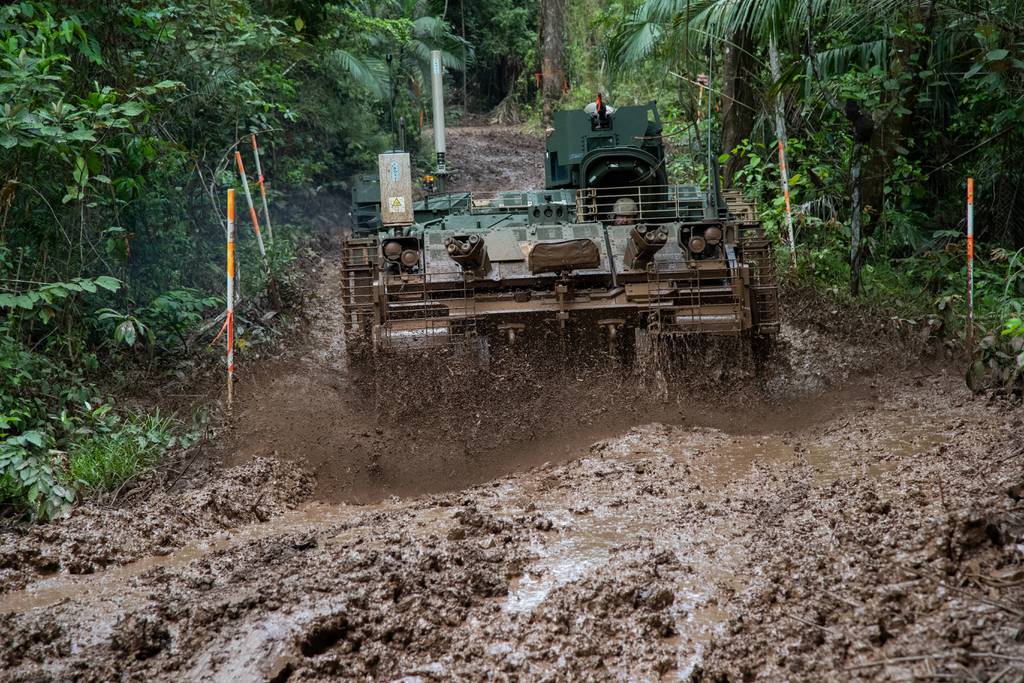
Yep -see in below:Finally got an answer to this (thanks, AUSA 2022). This fold-able cage is for combat in urban environments that have a lot of wires and other overhead snag hazards. It's meant to push hanging/dangling hazards out of the way so they don't tangle with the vehicle's antennae or the cupola. In more open environments, the crew would probably stow the thing or leave it off entirely.View attachment 679603
What the heck is this. Are we trying to be goofier than Russian and their cope cages?

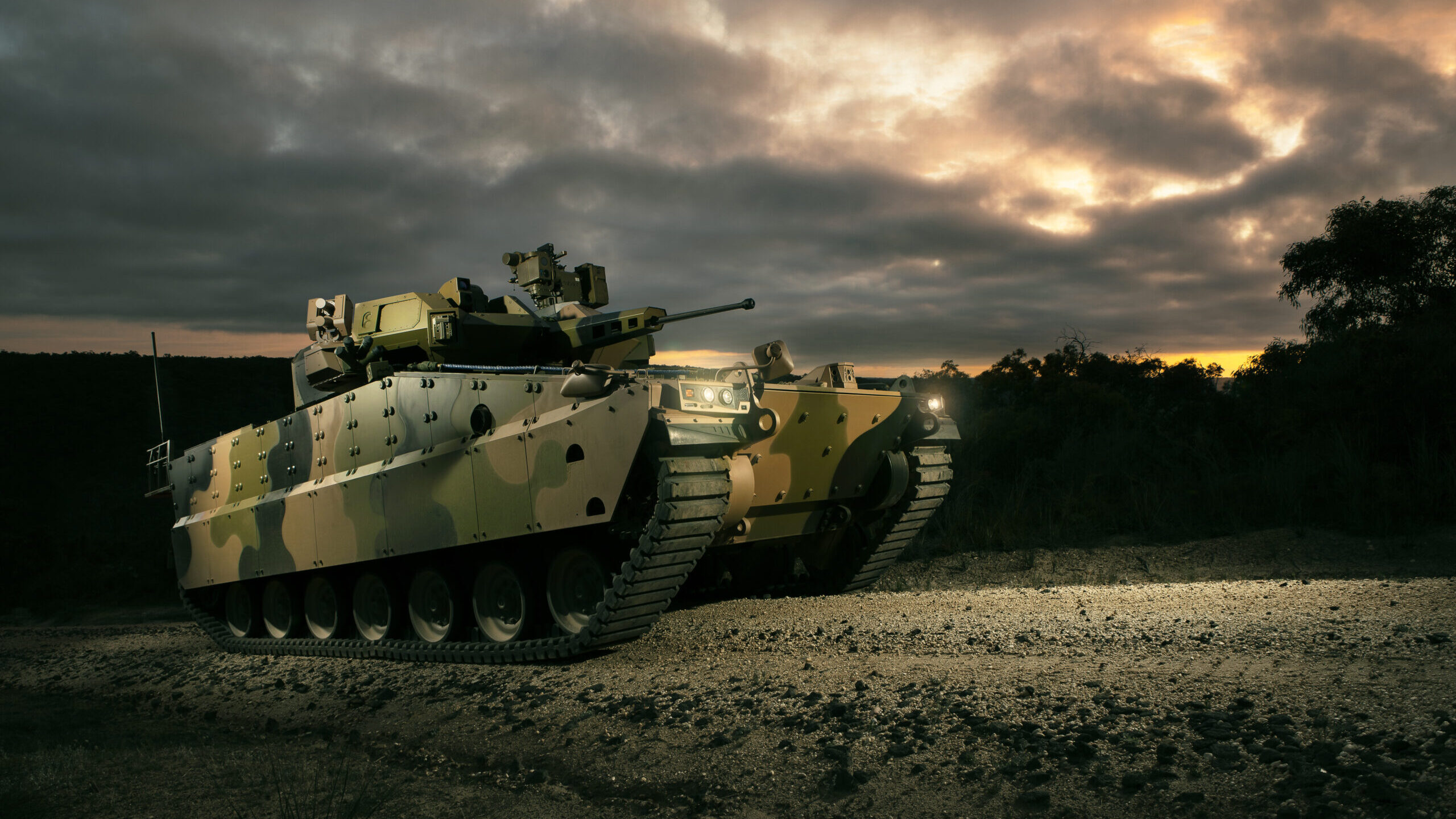
 euro-sd.com
euro-sd.com
..still dont see how anything but potentially more internal space for DEW and or UAS/munitions justifies a new vehicle most of the contenders look as if they have less internal volume. If Bradleys cannot be easily rejiggered for more internal space they may have to be scrapped.
SITREP – The US Army’s Optionally Manned Fighting Vehicle (OMFV)
The US Army’s Optionally Manned Fighting Vehicle (OMFV) programme is to replace the legacy M2 Bradleys.euro-sd.com
You have to consider that the turret on all of the contenders is unmanned so it's not taking up a large amount of that internal volume in the hull. I'd have to imagine you could cram eight infantrymen inside if they used the old-fashioned standards for seating like on the M2 or BMP, but these days everyone get more space and better seats...still dont see how anything but potentially more internal space for DEW and or UAS/munitions justifies a new vehicle most of the contenders look as if they have less internal volume. If Bradleys cannot be easily rejiggered for more internal space they may have to be scrapped.
SITREP – The US Army’s Optionally Manned Fighting Vehicle (OMFV)
The US Army’s Optionally Manned Fighting Vehicle (OMFV) programme is to replace the legacy M2 Bradleys.euro-sd.com
At that point you're going to have to get rid of the guys in back too and you've created an interesting ATGM carrier but not an infantry fighting vehicle.Almost reaching the stage where you say 'stuff TOW' and 40~50mm, put 7.62 and 25~~30 mm in turret for soft-skins, plus modular 'silos' in back for top-kill of AFVs and tanks...
havent heard that the squad in 1 vehicle problem has been solved yet..understand GCV was cancelled because it weighed too much..it weighed too much because it carried a full 9-11person squad. please inform if different.You have to consider that the turret on all of the contenders is unmanned so it's not taking up a large amount of that internal volume in the hull. I'd have to imagine you could cram eight infantrymen inside if they used the old-fashioned standards for seating like on the M2 or BMP, but these days everyone get more space and better seats...still dont see how anything but potentially more internal space for DEW and or UAS/munitions justifies a new vehicle most of the contenders look as if they have less internal volume. If Bradleys cannot be easily rejiggered for more internal space they may have to be scrapped.
SITREP – The US Army’s Optionally Manned Fighting Vehicle (OMFV)
The US Army’s Optionally Manned Fighting Vehicle (OMFV) programme is to replace the legacy M2 Bradleys.euro-sd.com
IMHO 7.62s CROWS are to be independent of main autocannons.Is it me or are these designs lacking a coaxial 7.62mm MG? I'd have to think that would be a problem since you're not going to be carrying nearly as many 50mm shells as 25mm.
That is one of the reasons GCV got cancelled. Though FCS-MGV was supposed to do it somehow while weighing only 40 tons or so. Maybe demands for armor protection are that much higher for these later programs. As for the ideal squad size I do not know. The US Army had been using 9 man squads in recent history but I don't know if they're rethinking that. M2 platoons had the squads split across vehicles and it was found that it could be quite challenging to keep it all organized.havent heard that the squad in 1 vehicle problem has been solved yet..understand GCV was cancelled because it weighed too much..it weighed too much because it carried a full 9-11person squad. please inform if different.
8 is too few if studies say ~15 might be the best dismounted sqd formation for combat power and maneuver options..
That's great to have but I don't think replacing the coax MG with it is a smart choice. When the gunner aims the turret and main gun at something having that ability to switch right to the coax MG without having to aim something else is very useful. It's the same way with tanks.IMHO 7.62s CROWS are to be independent of main autocannons.
thank you for the information and yes had heard about the difficulty maintaining organization. OMFV doesnt appear to solve the problem and maybe automation gear like IVAS is the only solution...but better not break or be jammed.That is one of the reasons GCV got cancelled. Though FCS-MGV was supposed to do it somehow while weighing only 40 tons or so. Maybe demands for armor protection are that much higher for these later programs. As for the ideal squad size I do not know. The US Army had been using 9 man squads in recent history but I don't know if they're rethinking that. M2 platoons had the squads split across vehicles and it was found that it could be quite challenging to keep it all organized.havent heard that the squad in 1 vehicle problem has been solved yet..understand GCV was cancelled because it weighed too much..it weighed too much because it carried a full 9-11person squad. please inform if different.
8 is too few if studies say ~15 might be the best dismounted sqd formation for combat power and maneuver options..
agree crews should have both coaxial and RWS, but that may cause its own problems.That's great to have but I don't think replacing the coax MG with it is a smart choice. When the gunner aims the turret and main gun at something having that ability to switch right to the coax MG without having to aim something else is very useful. It's the same way with tanks.IMHO 7.62s CROWS are to be independent of main autocannons.
At that point you're going to have to get rid of the guys in back too and you've created an interesting ATGM carrier but not an infantry fighting vehicle.Almost reaching the stage where you say 'stuff TOW' and 40~50mm, put 7.62 and 25~~30 mm in turret for soft-skins, plus modular 'silos' in back for top-kill of AFVs and tanks...
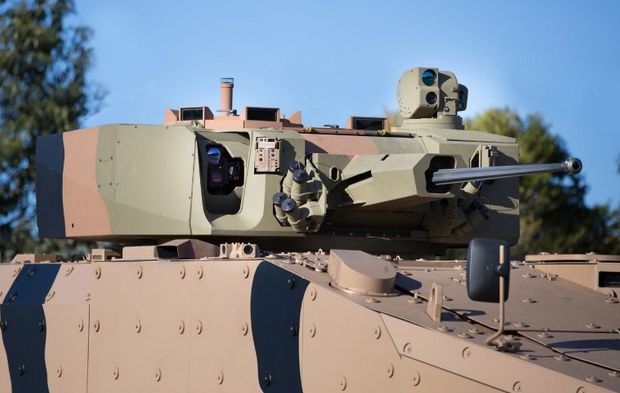
What do you mean by mine boxes? Full sized ATGMs are going to be larger than miniature APS or anti-drone missiles. It might not be impossible but the end result is definately going to be a pretty big vehicle, although it could be worth it if you've got the logistics for that.At that point you're going to have to get rid of the guys in back too and you've created an interesting ATGM carrier but not an infantry fighting vehicle.Almost reaching the stage where you say 'stuff TOW' and 40~50mm, put 7.62 and 25~~30 mm in turret for soft-skins, plus modular 'silos' in back for top-kill of AFVs and tanks...
It's just a recognition that the distinctions between varying forms of fighting vehicle are disappearing more than anything.
M2 Bradley was going to have VLS silos in the mine boxes for carrying APS and potentially anti-drone missiles with SIDS anyway, so I'm not sure why you think a fighting vehicle can't have all of that and still carry people, tbh. Bradley already weighs somewhere north of 40 tons with the full BUSK and mine protection package, and the fancy CITV, so it's not like a 40-60 ton IFV is much different in transportation requirements anyway.
The optimal vehicle for future soldiers might be a single "omni-/multi-purpose fighting vehicle" (an "OMFV") which has something around 4-6 dismounts, a 50-75mm cannon firing HEVT and APFSDS with 40-60 rounds onboard, a 30-40mm airburst RWS for anti-drone defense of the platoon's air defense, top attack protection against 40-60mm artillery bomblet grenades and 120-155mm EFPs, top-attack/direct attack anti-tank missiles akin to Javelin (or better, SRAW), protection against its own main armament along the forward arc and 30mm APFSDS/125mm HEAT along the sides, possessing GALIX-like under-armor smoke/chaff/kinematic flares to confound mmW guidance and infrared seekers of guided weapons.
Of course RB301 isn't going to be that vehicle since it has to be built in a Bradley factory. OMFV might be closer, but RB301 is mostly just a Bradley with some volume shifted away around to different things; less volume on automotives and ammo, more volume on armor survivability and electronics, it seems. Bradley's turret is godawful tiny and the fact that they had to mount the -A3's CITV in so goofy a manner just proves that it's in dire need of replacement. While they're at it they can free up space by adding some meaty sponson motors like the MGV perhaps since the BUSK kits are essentially mandatory and Bradley's massive front engine is too anemic and the whole thing is struggling to go down hills, let alone up them, at this point.
I have no idea why you think the UT30 "lacks a coaxial" though. The .30 cal's plainly in the same spot as the Bradley's actual coax on the RB301, on the right side of the gun:
View attachment 692110
It's the same turret as the Redback, except the Redback uses the manned MT30 (it's slightly wider), while the RB301 uses the robotic UT30.
